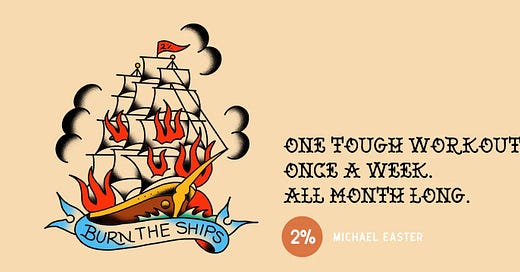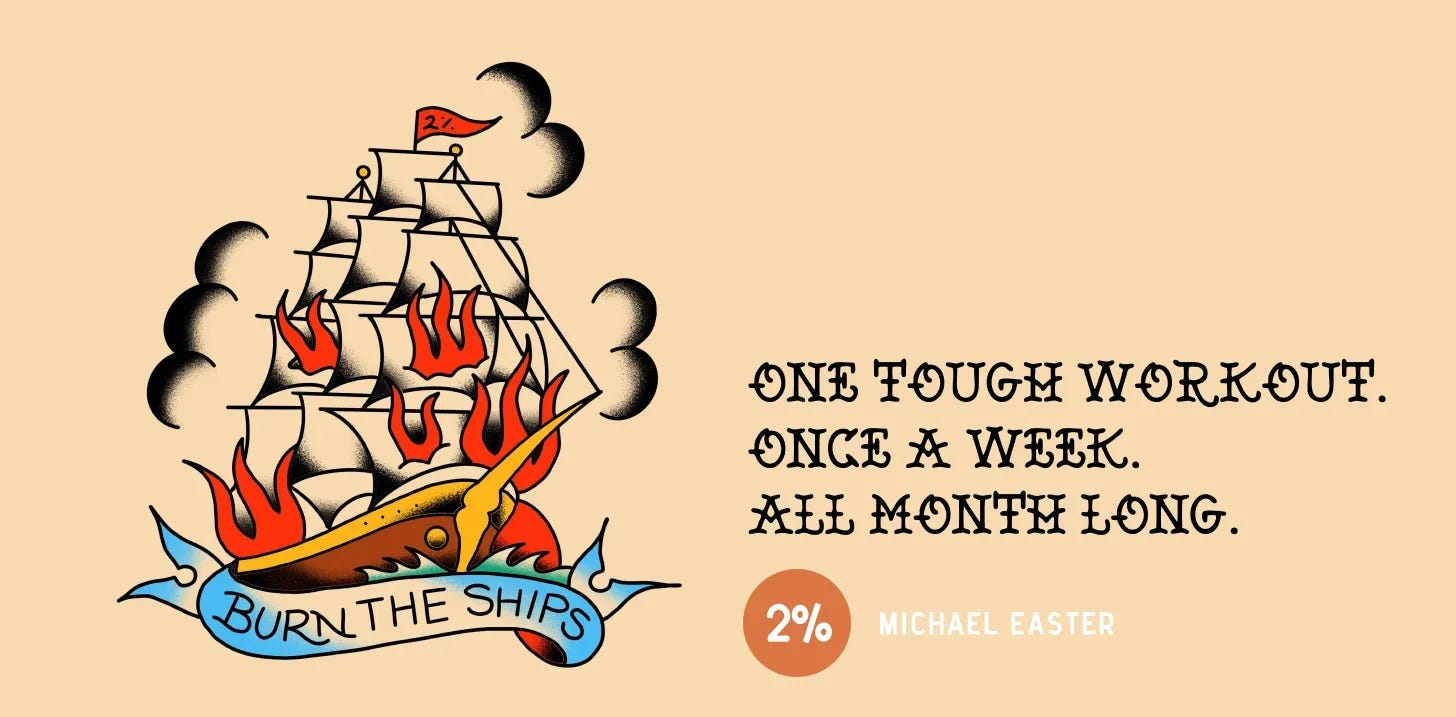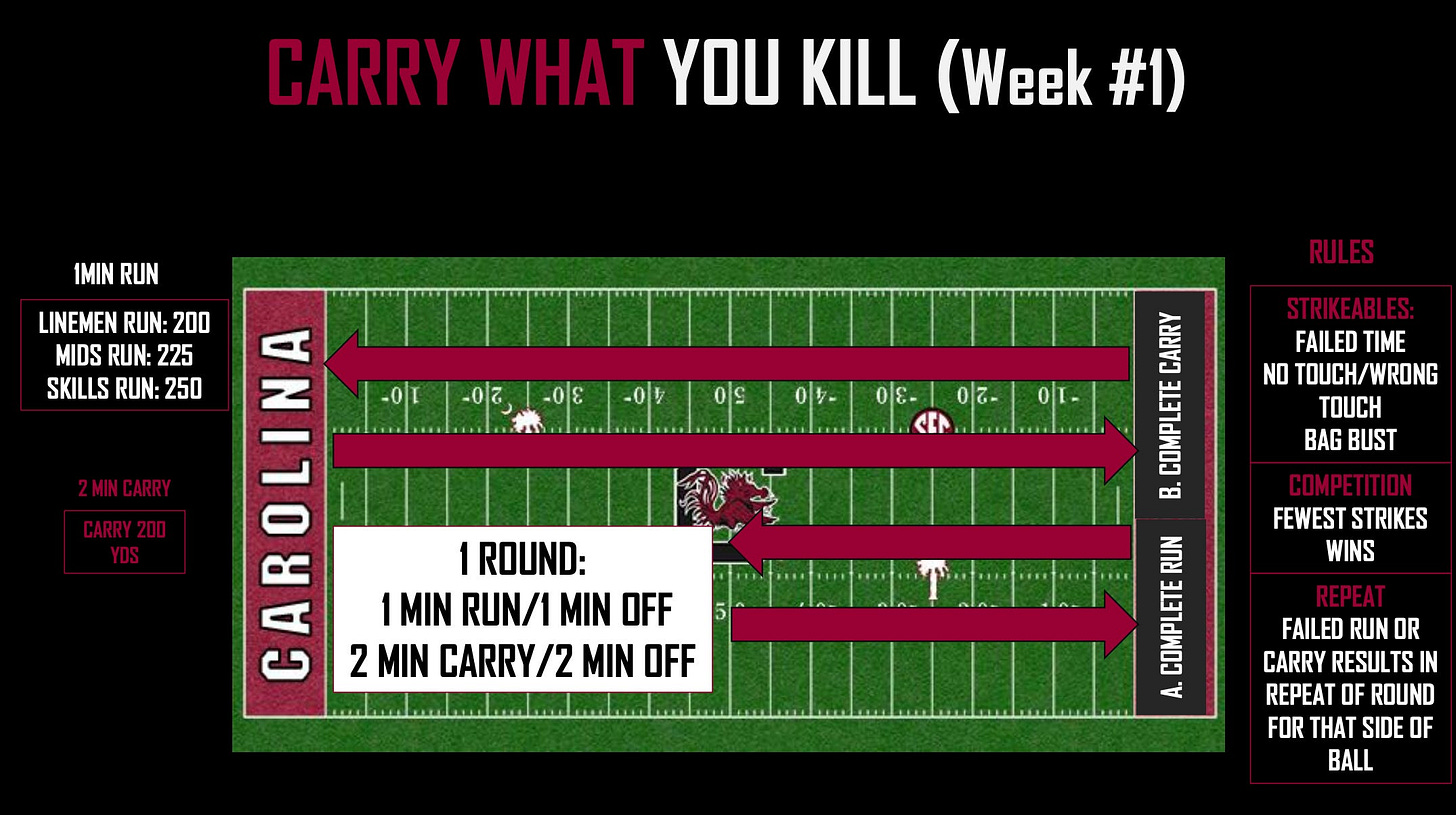The July edition of Burn the Ships drops now. This tough weekly workout will improve your performance and help you not break Rule 2. Do the workout every Friday.
Why it matters: Doing one challenging workout a week has physical and mental upsides. And doing it on Friday (or over the weekend) is a positive, life-giving way to end the workweek.
Some housekeeping
I was on the MTNTOUGH Podcast. Listen here. MTNTOUGH is also offering 2% readers 6 weeks of training on their app for free. Claim it here. The app has tons of great fitness plans for people who want to perform well in the mountains—and in life.
This post is fully accessible to Members, who are people who like to burn the ships and have fun and not die.
To access the entirety of this post, become a Member below.
Note that the audio readings of Member posts on Wednesday and Friday are located at the bottom of the page, just above our excellent sponsor shoutouts. (Also props to Maui Nui, GORUCK, and Momentous Nutrition for being sponsors … extra thanks to GORUCK for the larger discount on sandbags for this month’s Burn the Ships workout. Code below.).
Special shoutout to Fernando Delaserna for the Burn the Ships image above. He’s one of the last great American Traditional tattoo artists and based in Las Vegas. We now slapped the image onto a ruck patch.
Let’s roll …
I started doing one tough workout every Friday after my time reporting inside Gym Jones roughly 12 years ago. I’ve kept up the practice.
That’s because there’s an upside to pushing it once a week. Scientists at King’s College in London analyzed 53 studies on how intense exercise impacts mental health. They found that it led to “improvements in mental wellbeing, depression severity, and perceived stress compared to non-active controls, and small improvements in mental wellbeing compared to active controls.”
Intense exercise also seems to have a slight edge over less intense exercise for increasing VO2 max, which is associated with all sorts of good physical outcomes.
In other words, all exercise helps. But it probably makes sense to go hard sometimes.
Yet more isn’t always better when it comes to intense exercise. The smartest trainers I regularly speak with suggest that one tough workout a week is the sweet spot for health and performance. More than that, and we tend to get burned out and beat down. Less than that, and we miss out on some health and performance upsides.
Enter Burn the Ships.
Burn the Ships: How it works
On the first Friday of every month, we publish a new workout for Members only on 2%.
Our task is to do the workout every Friday for the rest of the month. (Don’t sweat if you can’t do it Friday—just try to do it sometime each week.)
These workouts are safe and effective, and they improve your strength, cardio, movement quality, and—in turn—your life. We’ve provided scaled versions and exercise swaps, so anyone and everyone can do them.
In other words, we’re pushing edges and improving safely. It’s easy to be hard but hard to be smart.
“It’d be a lot cooler if you did …”
2% is a cult whose Kool-Aid is a desire to improve ourselves and the world.
And as a cult, we should be interacting and spreading our weird message.
If you like, spread the workout on social media. Tag me and use #burntheships
Or don’t if you think social media is a wasteland. Which it can be—unless you’re using it to share fun group workouts and build a cult that helps people. :)
(I’m kidding about the cult thing … or am I?)
This Month’s Workout: Carry What You Kill
Why the name?
On July 3rd, we covered how and why the University of South Carolina is changing college football training by leveraging four key movements humans evolved to do.
Covering ground and carrying makeup two of those four movements.
Our species is unique in our ability to run great distances in the heat and carry weight. We’d run down animals, kill them, then carry the meat back to camp. Hence the name, Carry What You Kill.
Why it works
In a presentation on his training methods, Luke Day, the Head Football Strength & Conditioning Coach at the University of South Carolina, said: “When we came to the part of The Comfort Crisis about carrying and how it gave us a predatorial edge, we decided to add it to our long runs. Everyone runs, and everyone says they are training the demanded energy systems of football. But if we are not including a skill that made us the food chain champions, are we really developing our players to their fullest potential? The result? We took a page from legendary Michigan Strength Coach Mike Gittleson’s ‘Getting Yards’ drill and married it to (carrying).”
He continued, “The result was a difficult aerobic and cardiovascular demand paired with a loaded chassis demand expressed via the gait pattern while in a fatigued state; The ‘sweet spot,’ as Michael Easter puts it.” Translation: It forces you to carry and cover ground while tired. That builds epic endurance, functional strength, and toughness.
“I realized we needed to call this drill ‘Carry What you Kill,’” Luke said. “Carry What You Kill asks our players to be strong while they run—and run while being strong. That’s what made humans who we are.”
Equipment needed
Something heavy-ish that you can carry. A sandbag is best (that’s what I’ve listed in the workout, and what the Gamecocks use).
If you don’t have a sandbag, I twisted GORUCK’s arm into upping the discount to 20% for Members of 2%. Use the code SB20EASTER … Simple Sandbags are the best bang-for-buck option, while the Sandbag 2.0 is an upgraded option.
But you can also use a heavy medicine ball, a ruck, a bag of sand from Home Depot, etc. Ideally, this weight is anywhere from ¼ to ½ of your body weight.
Time commitment
This should take you between 35 and 75 minutes.
Song I’m listening to while doing this workout
Sandstorm. It plays in the University of South Carolina football stadium at kickoff and whenever the team needs it during the game. Here’s a way-too-in-depth story from ESPN about how a song from a Finnish DJ took over the Gamecock football stadium. (And yes, despite our commitment to decency, we’re listening to electronica. I don’t make the rules. I just follow them.)
If this workout were an animal, it would be a:
Gamecock. Obviously.
A note about this workout:
Luke and I collaborated to adapt Carry What You Kill for the purposes of 2%. The Gamecocks do a different version of the workout as an end to a day of training. Here’s what the team does:
“I'm not sure how hard our drill would be if you just did it on its own, as a standalone,” said Luke. “It’s so hard for us because we’ve done an hour and a half of brutal work before it, and you’ve exhausted all of your capacities at that point.”
To make the workout a tough enough standalone, Luke and I added more rounds and greater distances, and included crawling and a level change, the other two fundamental human movements.
How to do it
Note: we have substitutions and videos below if you have trouble with any gear or exercises.





